Footnotes*
- Share via
For almost 2000 years, Christians have celebrated Christmas as the birthday of Jesus of Nazareth. But people had celebrated the winter solstice for centuries before that. The winter solstice is the time in the Northern Hemisphere when the sun is the farthest south of the equator, resulting in the year’s longest night. It usually happens around Dec. 22. The exact date of Jesus’ birth is unknown. Dec. 25 was selected by Pope Julius I in the 4th century as the date to celebrate Jesus’ birth.
* For early Christians, Christmas was a solemn occasion for prayer and reflection. The nonreligious customs of gift-giving, feasting and decorating gradually became incorporated into the Christmas experience. Christmas was outlawed in England in 1644. Puritans and some other Protestant groups considered Christmas a pagan celebration.
* Still, German legend has it that Martin Luther himself was the first to add lights to a Christmas tree. And it is commonly believed that the Christmas tree was popularized in England by Prince Albert, the German husband of Queen Victoria. America’s first public outdoor Christmas tree with electric lights was erected in New York City in 1912.
* Today, the mythical gift-bringer is a common element in Christmas celebrations around the world: St. Nicholas, Santa Claus or Kris Kringle here in the U.S.; Father Christmas in England; Pere Noel in France; Old Befana in Italy; Jultomten in Sweden.
The image we have today of Santa Claus traces back to the poem “A Visit From St. Nicholas” (‘Twas the night before Christmas...) by Clement C. Moore, written in 1822. Moore, a professor at General Theological Seminary in New York City who had previously written a scholarly tome, “A Compendious Lexicon of the Hebrew Language,” wrote the poem for his own children. He initially resisted having “A Visit From St. Nicholas” published, because he felt it was beneath his dignity as a scholar.
More to Read
Sign up for Essential California
The most important California stories and recommendations in your inbox every morning.
You may occasionally receive promotional content from the Los Angeles Times.













